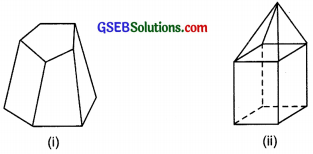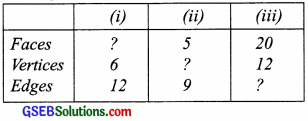Gujarat Board GSEB Textbook Solutions Class 8 Maths Chapter 10 Visualizing Solid Shapes Ex 10.3 Textbook Questions and Answers.
Gujarat Board Textbook Solutions Class 8 Maths Chapter 10 Visualizing Solid Shapes Ex 10.3
Question 1.
Can a polyhedron have four its faces
- 3 triangles?
- 4 triangles?
- a square and four triangles?
Solution:
A polyhedron is bounded by four or more than four polygonal faces.
- No, it is not possible that a polyhedron has 3 triangles for its faces.
- Yes, 4 triangles can be the faces of a polyhedron.
- Yes, a square and 4 triangles can be the faces of a polyhedron.
![]()
Question 2.
Is it possible to have a polyhedron with any given number of faces?
Hint:
Think of a pyramid.
Solution:
Yes, it can be possible only if the number of faces is four or more than four.
Question 3.
Which are prisms among the following?

Solution:
Since, a prism is a polyhedron having two of its faces congruent and parallel, whereas other faces are parallelogram.
- No, a nail is not a prism.
- Yes, unsharpened pencil is a prism.
- No, table weight is not a prism.
- Yes, box is a prism.
![]()
Question 4.
- How are prisms and cylinders alike?
- How are pyramids and cones alike?
Solution:
- Both of the prisms and cylinders have their base and top as congruent faces and parallel to each other. Also, a prism becomes a cylinder as the number of sides of its base becomes larger and larger.
- The pyramid and cones are alike because their lateral faces meet at a vertex. Also a pyramid becomes a cone as the number of sides of its base becomes larger and larger.
Question 5.
Is a square prism same as a cube? Explain?
Solution:
No, not always, because it can be a cuboid also.
Question 6.
Verify Euler’s formula for these solids?

Solution:
(i) In figure (i), we have
F = 7, V= 10 and E = 15
∴ F + F = 7 + 10 = 17
F + V – E = 17 – 15 = 2
i.e., F + V – E = 2
Thus, Euler’s formula is verified.
(ii) In figure (ii), we have
F = 9, V = 9 and E = 16
∴ F + V = 9 + 9 = 18 and
F + V – E = 18 – 16 = 2
i ,e., F + V – E = 2
Thus, Euler’s formula is verified.
![]()
Question 7.
Using Euler’s formula find the unknown?

Solution:
1. Here, V = 6 and E = 12
Since F + V – E = 2
∴ F + 6 – 12 = 2 or F – 6 = 2
or F = 2 + 6 = 8
2. Here, F = 5 and E = 9
Since F + V – E = 2 or
∴ 5 + V – 9 = 2
or V – 4 = 2
or V = 2 + 4 = 6
3. Here F = 20 and V = 12
Since, F + V – E = 2
∴ 20 + 12 – E = 2
32 – E = 2
or E = 32 – 2 = 30
![]()
Question 8.
Can polyhedron have 10 faces, 20 edges and 15 vertices?
Solution:
Here, F = 10, E = 20 and V = 15
We have: F + V – E = 2
∴ 10 + 15 – 20 = 2 or
25 – 20 = 2
or 5 = 2 which is not true
i.e., F + V – E ≠ 2
Thus, such a polyhedron is not possible.